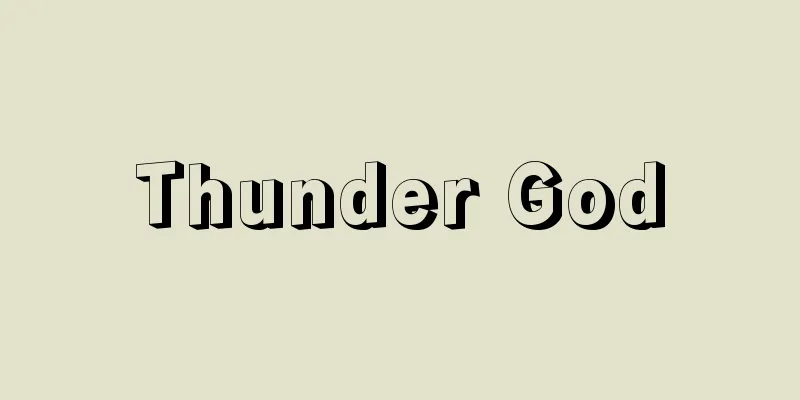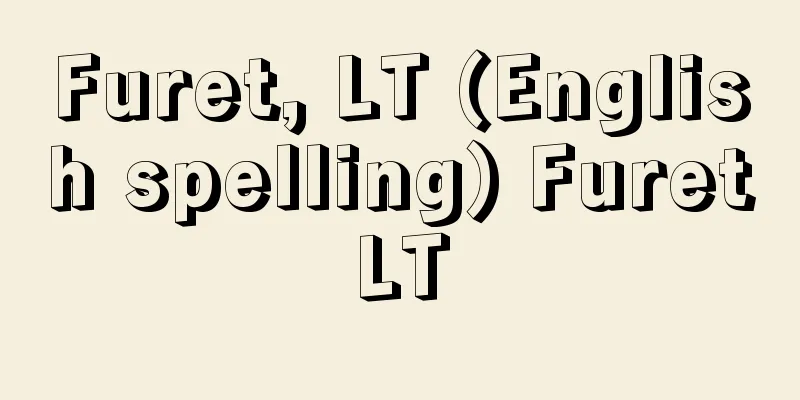Thunder God

|
A deification of thunder and lightning. A god who causes thunder. According to Tsumura Soan's "Tankai" (1795), there is a thunder god in the center of the four directions, and his name is found in the "Saishōōkyō Sutra." It is said that if you put a sign with his name on it on the ceiling, lightning will not strike. Like lightning, he is said to bring good rice harvests, and in areas such as the Kanto Plain, where lightning is common, if there is lightning in the fields, they will not grow crops in that area for a year and will hang shime (decorative ornaments). In the Kanto Plain, where upland rice is grown in large amounts, there are many small shrines dedicated to the thunder god, as they would be in trouble if there was no rain. In the foothills of Mount Tsukuba in Ibaraki Prefecture, there is a custom in which, when thunder rumbles, a young man walks around the rice fields carrying a sickle attached to the end of a long bamboo pole, driving away the god of thunder. Tochigi Prefecture is the place with the most lightning in Japan, and there are several Raiden Shrines in the former Ohira-machi area of Tochigi City, Tochigi Prefecture. Fukushima Prefecture is also known as a place with a lot of lightning, and small shrines to the god of thunder are enshrined in each village. Belief in the god of thunder has been seen in Japan since ancient times, and in the Nihon Shoki and other texts, the deity is said to be a snake. In the Heian period, it became linked to faith in spirits, and Sugawara no Michizane, enshrined at Kitano Tenmangu Shrine, was also known as Karai Tenjin, and it is said that lightning will not strike any place where he is enshrined. In the "Kitano Tenjin Engi" picture scroll and other illustrations, the thunder god is depicted as an ogre holding a drumstick and carrying a tanadaiko drum. In art, the thunder god is often depicted paired with the wind god. [Oto Tokihiko] [Reference] | | |Source: Shogakukan Encyclopedia Nipponica About Encyclopedia Nipponica Information | Legend |
|
雷鳴と稲妻を神格化したもの。雷(かみなり)をおこす神。津村淙庵(そうあん)の『譚海(たんかい)』(1795)によれば、東西南北の中央に雷神があり、その名号(みょうごう)は『最勝王経』にあるとあり、その名号を書いた札を天井に貼(は)っておくと雷が落ちないという。稲妻というように稲の豊作をもたらす神とされ、落雷の多い関東平野などでは、田畑に落雷があるとその場所は1年だけ作物をつくらず注連(しめ)を張っておくという。陸稲を多くつくる関東平野では雨がないと困るので雷神を祀(まつ)った小祠(しょうし)が多くみられる。茨城県の筑波山麓(つくばさんろく)では、雷鳴がおこると青年が長い竹の先に鎌(かま)をつけたものを担いで田の周りを歩き、雷神を追い払う習俗がある。栃木県は全国でいちばん雷の多い土地であり、同県栃木市旧大平(おおひら)町地区には雷電神社というのが数社ある。福島県も雷の多い土地として知られ、雷神の小祠が集落単位で祀られている。わが国では古代以来雷神信仰がみられ、『日本書紀』などでは神体は蛇体とされている。平安時代には、御霊(ごりょう)信仰と結び付き、北野天満宮に祀られている菅原道真(すがわらのみちざね)は火雷(からい)天神ともいわれ、これを祀っている所には落雷することはないといわれている。『北野天神縁起』絵巻などに、雷神は鬼の形で、手に桴(ばち)を持ち連太鼓を負う姿で描かれている。また美術では、風神と一対になって造形されるのが例である。 [大藤時彦] [参照項目] | | |出典 小学館 日本大百科全書(ニッポニカ)日本大百科全書(ニッポニカ)について 情報 | 凡例 |
Recommend
Ibokisago - Ibokisago
A gastropod snail of the family Celastridae of th...
Wooden door - Itatobira
...In the Zen style, the perimeter is made up of ...
Sultan al‐Aṭrash
1891‐1982 A Lebanese Druze political leader. He ca...
Eucharist - Thanksgiving
…It comes from the Biblical Greek word eucharisti...
Impact loan
Originally, it meant a loan necessary for importin...
Grimoald
Dagobert I established a sub-kingdom for the east...
Lliga
…While studying at the University of Barcelona, ...
Diaper rash
Also known as diaper dermatitis. The area that com...
Ando Yueki
A mathematician in the early Edo period. He studi...
Shadow Blue - Inchin
It is a type of white porcelain, also called blue...
Liatris pycnostachya (English spelling) Liatris pycnostachya
… [Munemin Yanagi]. … *Some of the terminology th...
Oryginae
...All of them are native to Africa, and there ar...
Ubayraz - Ubayraz
...This is due to the idea that milk is the same ...
Dangerous painting - Dangerous painting
A term used in ukiyo-e. A type of ukiyo-e painting...
Granite porphyry (English spelling: granite porphyry)
Porphyritic rock of granite composition. Generally...









